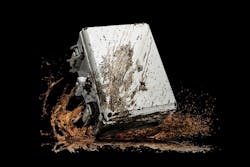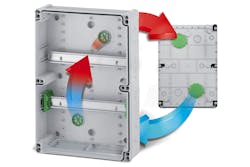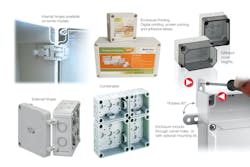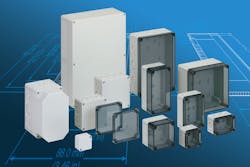Problem 1
We’re facing a severe application that is consistently exposed to very high and very low temperatures along with rain, snow, and/or high winds. A sealed enclosure is very important.
Solution 1
Consider using specially designed polycarbonate enclosures that provide UV as well as all-weather protection (with temperature variations between the range of -35 degrees C to +80 degrees C. Through the use of a specifically designed seal arrangement, such as the “Drain Protect” system from Altech Corp, users are guaranteed the highest protection against the elements. Even for use inside a factory where the atmospheres may be filled with oils, greases, or propose mechanical stresses on the enclosure such as vibration and shock, polycarbonate enclosures stand up well, providing corrosion resistance along with high impact resistance.
Problem 2
Our applications can vary from one installation to the next. We’d like to know about solutions that offer a lightweight, modular approach that would be easy for us to adjust and customize when needed. Finding such an enclosure solution has been difficult.
Solution 2
When your needs have to do with the flexibility of the solution you choose, consider polycarbonate enclosures such as those offered in the GEOS Series from Altech Corp. These enclosures are offered with multiple mounting options as well as a modular component mounting system. Because the enclosure material is easy to machine, a wide variety of custom and semicustom adjustments can be easily incorporated. Further, their lightweight design makes them ideal for applications where tough capabilities and weight sensitive specifications are required.
Problem 3
Safety is our primary concern regardless of the application we need a solution for. We need to do this even while protecting the internal components, which means protecting internal electronics from accumulated moisture buildup that can cause short circuits but also shock to technicians who need to get inside the enclosure.
Solution 3
As you’ve indicated, safety often needs to be approached in a variety of different ways, each with its own issue.An Example Application for Agricultural Environments
Most engineers who hear the words harsh environments think of industrial environments where oil, grease, dirt, vibration, and other physical conditions are present inside a manufacturing plant or chemical refinery. But there are other environments that are equally harsh to sensitive equipment. One of those is the agricultural business. Modern agricultural operations can be exposed to constant dirt, crop dust, physical impact, and highly extreme temperatures, not to mention storms, flooding, and much more. Further, farm environments, unlike industrial environments, are around animal waste (primarily ammonia), which is corrosive to many materials.
Non-metallic polycarbonate enclosures offer the performance advantages and attributes this industry environment requires to maintain long-term smooth operations—compared to metal enclosures. Polycarbonate enclosures can house and protect electrical lines, lighting controls, switchgear, safety and security wiring, as well as the highly sophisticated electronics now being used in agricultural businesses around the world. Plus, these enclosures offer livestock safety.
Polycarbonate enclosures offer other advantages in addition to basic ruggedness and flexibility mentioned above (see Figure 2). The enclosures also meet various relevant standards, including UL94 (Flammability of Plastic Materials, NEMA IP66/67 (particle and water ingress), VDE 0471 (fire hazard), and IK07 (impact). Particularly for the agricultural environment, polycarbonate enclosures are able to tolerate very high concentrations of ammonia, meeting the stiff certification requirements of the German Agricultural Society (Deutsche Landwirtschafts-Gesellschaft, or DLG). They can withstand an ammonia concentration of 750 ppm (parts per million) at 70 degrees C and 70 percent humidity over 1,500 hours of continuous testing.
Also mentioned above, are the physical customizations available. While the physical sizes of polycarbonate enclosures are standardized, this is not a serious constraint, as they are available in a wide range of height, width and depth dimension combinations (see Figure 3). Once a basic enclosure is chosen, additional attributes and features can be customized, including value-added work to reduce end-user effort. Variations include a choice of hinge type (internal, external); choice of mounting style and orientation; different panel cutouts for displays, indicators, keypads, and other functions; pre-packaged connectors and pushbuttons; imprinting and labeling; and a choice of transparent or opaque cover. Polycarbonate enclosures have already had an impact on the agricultural market and their many variations in needs.




